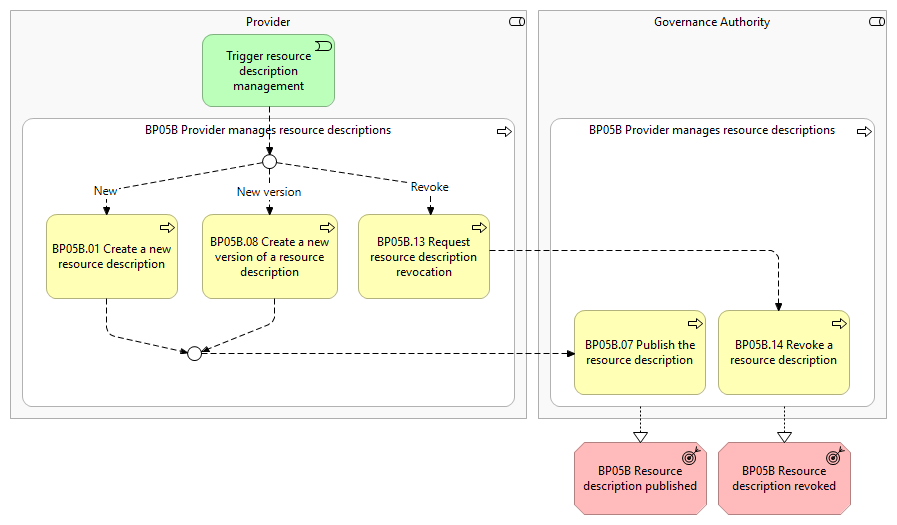BP05B - Provider manages resource descriptions
To help understand the content of this document, readers should familiarize themselves with the key definitions and actors.
Overview
This business process covers the management of resource descriptions in the data space catalogue by both a Provider and the Governance Authority.
It includes the following main steps:
- Create a new resource description: The Provider creates a new resource description with the required and optional contents, signs and submits it to the Governance Authority for publication in the data space catalogue.
- Create a new version of a resource description: The Provider creates a new version of a resource description based on an already existing resource description, updates the contents, signs and submits it to the Governance Authority for publication in the data space catalogue. This corresponds to an update, as resource descriptions are immutable and cannot be changed.
- Request resource description revocation: The Provider sends a request to revoke a resource description from the data space catalogue to the Governance Authority
- Publish a resource description: Having received a request to create a new resource description, or a new version of a resource description, the Governance Authority validates the received resource description and publishes it in the data space catalogue, if valid. Consumers of an existing resource description are informed about the new version. The old version of the resource description is revoked by the Governance Authority.
- Revoke a resource description: Having received a request to revoke a resource description, the Governance Authority revokes the resource description from the data space catalogue. Consumers of the resource description are informed about the revocation.
Actors
The following actors are involved:
- Governance Authority
- Provider
Assumptions
The following assumptions are made:
- The creation of a new resource description or a new version of a resource description always uses the latest version of a schema.
- If a new version of a resource description is created, usage contracts based on the old version continue without alteration.
- The revocation of a resource description does not alter or terminate usage contracts based on the specific resource description, which can still be inspected by the Consumer. Only new usage contracts are not possible any more with the revoked resource description, as they are no longer available in the data space catalogue.
Prerequisites
The following prerequisites must be fulfilled:
- Data space is configured: The Governance Authority has configured the data space catalogue with the corresponding vocabulary and schemas (containing quality rules) to have the general structure of a resource description (Business Process 2). Furthermore data space specific configurations such as contract templates and similar must be defined.
- Provider onboarded: The Provider must be successfully onboarded (Business Processes 3A).
- Contract clauses are stored and available for inclusion in resource descriptions: The Provider must have created and stored at least one set of contract clauses so that these can be included in the resource description (Business Process 5A).
Details
The following shows the detailed business process diagram and gives the step descriptions.
Trigger resource description management
The Provider decides whether to create a new resource description, to create a new version of an existing own resource description, or to revoke an existing own resource description. This initiates resource description management.
BP05B.01 Create a new resource description
The Provider selects the resource type, data, application or infrastructure, and enters required and optional common metadata in the new resource description.
BP05B.02 Add resource type specific metadata
Depending on the selected resource type, the Provider adds the resource type specific required and optional metadata.
BP05B.03 Add policy and contract related metadata
For access and usage control, the Provider configures the policies that shall be applied to the new resource. Furthermore, the Provider needs to add required and optional metadata related to the usage contract for the specific resource.
BP05B.04 Sign and submit the resource description
After creating a new resource definition, or creating a new version of a resource description, the Provider signs new resource description with the Provider's credentials and submits it to the Governance Authority.
BP05B.05 Validate the resource description
When receiving a request to publish a new resource description, or a new version of a resource description, the Governance Authority performs the following validations:
- Syntactic validation.
- Semantic validation against schema and vocabulary.
- Validation of quality rules.
BP05B.06 Remediate validation issues
In case of validation issues, the Governance Authority informs the Provider about the issues. The Provider must remediate the issues and submit the resource description again to the Governance Authority for publication.
BP05B.07 Publish the resource description
Upon successful validation, the new (or new version of the) resource description is published in the data space catalogue.
BP05B.08 Create a new version of a resource description
The Provider selects a previously published resource description and initiates the creation of a new version of this resource description. The Provider updates the required and optional metadata in this new version.
BP05B.09 Update resource type specific metadata
Similar to step BP05B06 the resource type specific metadata can be updated for a new version of a resource description.
BP05B.10 Update policies and contract related metadata
Similar to step BP05B.07 the policies and contract related metadata can be updated for a new version of a resource description.
After this step, the creation of a new version of a resource description continues with signing and submitting, in the same way as for a new resource description.
BP05B.11 Revoke the previous version of the resource description
If the new version of the resource description is valid, the Governance Authority revokes the current resource description version.
BP05B.12 Inform about new version
If a resource description is updated, the Consumers of this resource are informed about the new version in the data space catalogue.
BP05B.13 Request resource description revocation
The Provider selects a previously published resource description and initiates the revocation of this resource description.
BP05B.14 Revoke a resource description
Upon receiving a request for revocation, the Governance Authority revokes the resource description from the data space catalogue.
BP05B.15 Inform about revocation
If a resource description is revoked, the Consumers of this resource are informed about the revocation.
Outcomes
- Resource description published: The publication of a new resource description, or a new version of a resource description is an outcome of resource description management. This makes the resource description discoverable for other Participants (Business Process 6).
- Resource description revoked: The revocation of an existing resource description is an outcome of resource description management.
| Business Process | Status: Proposed |
High Level Requirements
5B.1 - Application sharing - Handling the execution
Simpl shall support application sharing.5B.2 - Application sharing - Instructions sharing
Simpl shall make the application usage instructions available.5B.3 - Application sharing - Validation
Simpl shall manage the validation logic related to uploading an app to the catalog.5B.4 - Enable and enforce usage policies - Assignment of a policy
Simpl shall provide a mechanism to define new usage policies in ...5B.5 - Enable and enforce usage policies - Definition of a policy
Simpl shall provide a mechanism to define new usage ...5B.6 - Onboarding new dataset - Providing self-description
The Data Provider shall provide the characteristics ...5B.7 - Removing the self-description of a Dataset
Simpl shall, at any moment, give the Data Provider the possibility ...5B.8 - Subscription to a data/application/infrastructure - Provider
A data/application/infrastructure Consumer can at any moment stop...5B.9 - Validation of metadata onboarding - syntax, semantic and quality
Simpl shall verify the syntax, semantic and quality rules when onboarding ...5B.10 - Assign Contract Template
Simpl shall support providers to assign a contract template to ...5B.11 - Access policy
Simpl shall provide a UI and API through which ...

Moderator note: Comments are from the previous discussion platform.
Submitted by Marleen Valkenburg on Thu, 04/04/2024 - 11:41
The current description of this L0 is high-over, where I think it could use some information on how Data, Application and Infrastructure are defined and the role. Looking forward to the respective L1 and L2 requirements to get more details.
Please log in or sign up to comment.